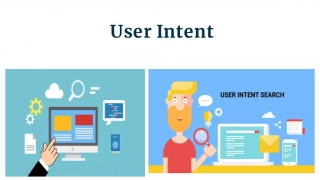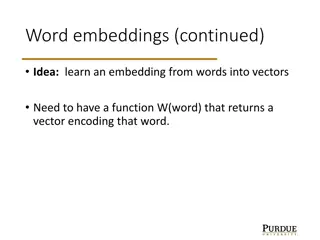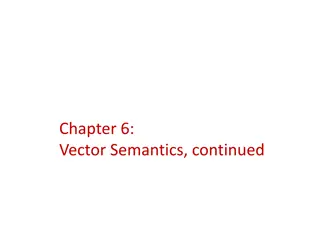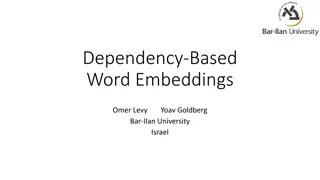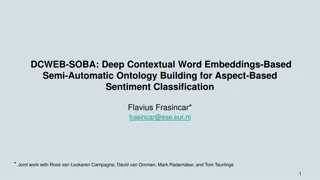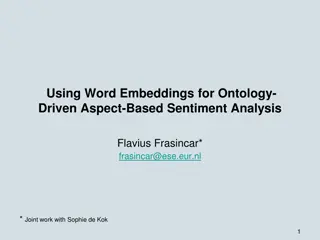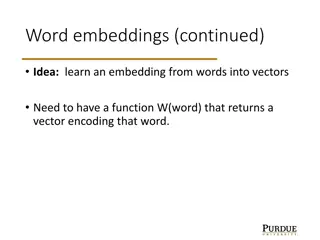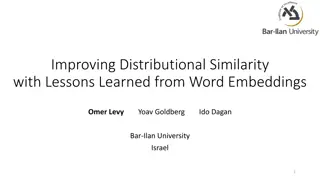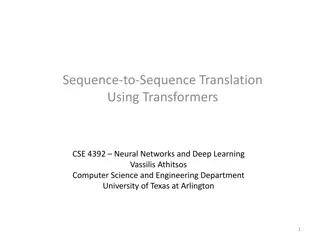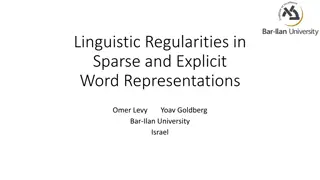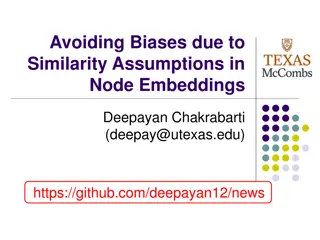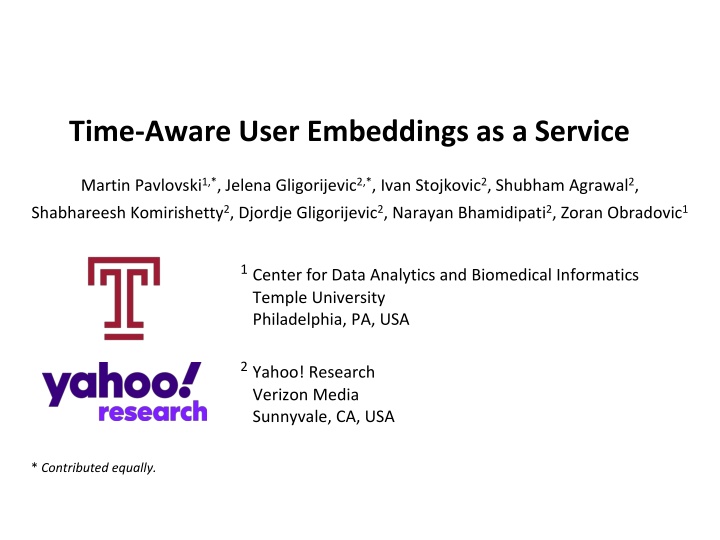
Time-Aware User Embeddings as a Service
Providing time-aware user/activity embeddings as a service to different teams within a company offers a centralized and task-independent solution. The approach involves learning universal, compact, and time-aware user embeddings that preserve temporal dependencies, catering to various applications such as advertising, user profiling, and recommendations. The Time-Aware Sequential Autoencoder (TASA) model is introduced to capture sequential activity order, maintain between-activity time gaps, and assign temporal scores, resulting in low-dimensional embeddings for efficient user representation.
Download Presentation

Please find below an Image/Link to download the presentation.
The content on the website is provided AS IS for your information and personal use only. It may not be sold, licensed, or shared on other websites without obtaining consent from the author. If you encounter any issues during the download, it is possible that the publisher has removed the file from their server.
You are allowed to download the files provided on this website for personal or commercial use, subject to the condition that they are used lawfully. All files are the property of their respective owners.
The content on the website is provided AS IS for your information and personal use only. It may not be sold, licensed, or shared on other websites without obtaining consent from the author.
E N D
Presentation Transcript
Time-Aware User Embeddings as a Service Martin Pavlovski1,*, Jelena Gligorijevic2,*, Ivan Stojkovic2, Shubham Agrawal2, Shabhareesh Komirishetty2, Djordje Gligorijevic2, Narayan Bhamidipati2, Zoran Obradovic1 1Center for Data Analytics and Biomedical Informatics Temple University Philadelphia, PA, USA 2Yahoo! Research Verizon Media Sunnyvale, CA, USA * Contributed equally.
Motivation and Challenges Motivation Providing time-aware user/activity embeddings as a service to other teams in a company Challenges Task-independence The stumbling block of user-level modeling Requires analyzing user trails (sequences of user activities) Need of a centralized and universal pool of user representations Can be used for any type of advertising, user profiling, recommendations, etc. individual teams are not burdened with efforts around understanding data, creating features, etc. Compactness Instead of using only a few readily available user features (like gender and age), Other extreme: coming up with activity- or interest-based features may result in billions of sparse features Temporal-awareness The intrinsic between-activity dependencies should be preserved The irregular time gaps should be accounted for
Problem Formulation Given: A sequence of user activities , along with their corresponding timestamps . Objective: Learn a function that projects a user to an embedding . Learn user embeddings: universal (task-independent) compact (low-dimensional) time-aware (preserves the temporal dependencies among a user s activities) such that * the representations of users with similar activity histories are nearby in the embedding space.
Time-Aware User Embeddings as a Service Time-Aware Sequential Autoencoder (TASA) Learns task-independent embeddings by autoencoding sequences of user activities Captures the sequential activity order by leveraging an LSTM-based encoder/decoder Preserves between-activity time gaps by introducing stop features Models the influence of activities and their timestamps by assigning temporal scores Generates low-dimensional embeddings allowing for subsequently leveraging low-latency models Service Pipeline Stage 1: Generation of sequences (user trails) Construction of user trails consisted of the top-K most frequent activities across multiple heterogeneous sources Stage 2: Model Training Incorporates TASA to learn time-aware embeddings of the user trails Stage 3: Embedding Incoming Activities/Users The trained TASA is used to embed incoming activities or entire user trails
Data YooChoose Public Dataset Source: RecSys 2015 Challenge (http://recsys.yoochoose.net) Activities: Clicks/buys of users over time Examples: 4, 428, 037 user sessions of activities 3, 985, 870 sessions in the training set | 442, 167 in the test set 4, 050, 782 sessions labelled as negative | 377, 255 as positive Vocabulary: 52, 739 unique activities User Activity Trails from Verizon Media Millions of user activity sequences from heterogeneous sources: Yahoo Search Commercial email receipts News and other content on publishers webpages associated with VM such as: o Yahoo homepage, Finance, Sports and News, advertising data (e.g., ad impressions and clicks) Vocabulary: 200,000 most frequent activities Conversions (labels) collected over one month for 3 different advertisers Selected 5% of the positive conversions Divided into training, validation and test sets using cut-off dates
Experimental Setup Baselines Unsupervised AE: Fully-Connected Autoencoder seq2seq: Seq2seq Autoencoder [1] TA-seq2seq: Time-Aware Seq2seq [2, 3] ISA: Integrated Sequence Autoencoder [4] Supervised LR: Logistic Regression attRNN: Attention-based RNN [5] XGBoost: eXtreme Gradient Boosting [6] [1] Sutskever, et al. Sequence to sequence learning with neural networks. NIPS 2014. [2] M. Baytas, et al. Patient subtyping via time-aware LSTM networks. SIGKDD 2017. [3] Bai, et al. Interpretable representation learning for healthcare via capturing disease progression through time. SIGKDD 2018. [4] Pei and MJ Tax Unsupervised Learning of Sequence Representations by Autoencoders. arXiv preprint 2018. [5] Zhou, et al. Understanding consumer journey using attention based recurrent neural networks. SIGKDD 2019. [6] Chen, et al. XGBoost: A Scalable Tree Boosting System. SIGKDD 2016.
Experimental Setup Evaluation metrics Unsupervised Reconstruction Accuracy ROUGE (Recall-Oriented Understudy for Gisting Evaluation) [7] BLEU (BiLingual Evaluation Understudy) [8] Supervised Area Under the ROC curve (AUC) Setup Embedding dimension: 100 Optimizer: Adam with a learning rate of 0.001 Batch sizes: VM user trails: 32 RecSys dataset: 64 Ran on a distributed TensorFlowOnSpark infrastructure 100 Spark executors Model parameters distributed among 5 executors. [7] Lin. Rouge: A package for automatic evaluation of summaries. Text summarization branches out, 2004. [8] Papineni, et al. BLEU: a method for automatic evaluation of machine translation. ACL 2002.
Results Sequence Reconstruction Proprietary VM dataset Reconstruction performance on the VM dataset. Discussion: TASA outperforms the alternatives, across all reconstruction measures. Leveraging temporal information (by TA-seq2seq and TASA) leads to more accurate reconstruction Nonetheless, seq2seq greatly outperforms AE o sequential modeling is an important basis for capturing the sequential nature of the user trails
Results Sequence Reconstruction Public RecSys dataset Reconstruction performance on the RecSys dataset. Discussion: AE, seq2seq, TA-seq2seq and TASA seems to obtain consistent performance Once again: seq2seq outperforms AE the time-aware variants manifest improvements over the ones that do not preserve time ISA specifically exhibits considerable performance (the second-best performing) TASA consistently outperforms other alternatives across all measures Larger improvements than those on the VM data
Results Conversion Prediction Company baseline: uses user demographic data * The AUC lifts are computed with respect to this baseline. All LR models from the left section of the table are trained on user demographic features concatenated with user embeddings. As for the right section of the table, the models are trained on one-hot encoded activities. Proprietary VM dataset The demographic data is not sufficient One-hot LR slightly improves the baseline With user embeddings + demographic features, TASA yields: o > 25% in AUC on Advertiser A o > 10% on Advertiser B o > 15% on Advertiser C Although LR is a supervised model, when trained on unsupervised embeddings, it attains greater performance due to the sequential nature of the trails: o captured by the sequential variants o not by LR 1-hot LR achieves its highest performance: When trained on TASA s user embeddings Even achieves comparable performance to attRNN
Results Purchase Prediction Public RecSys dataset LR(TASA) consistently outperforms the alternatives Almost as good as attRNN Sequential and/or time-aware variants outperform the one-hot LR Predictive performance in terms of AUC on the (public) RecSys 2015 challenge dataset. Observations: TASA can be trained offline once and readily applied across tasks Allows for subsequently leveraging low-latency models to accommodate serving time
Service Pipeline A Bird s-eye View Data Sources Model Training sequence generation input output user trail user Conversion Prediction embedding Click Prediction Model weights Centralized pool of embeddings Encoded representation Ad Recommendation Apply Model incoming sequence of activities user embedding
Service Pipeline Conversion Prediction * Utilized by several teams as a source of additional user features, mainly for offline experimentation Pipeline Evaluation Performance improvements introduced by the service pipeline on four in-house conversion prediction tasks. Offline experiments Data: Four sets of audiences Task: Conversion prediction Relative AUC lifts XGBoost utilizing TASA s + current production features Relative to a model built using only the production features Note: 1) The production system is a very strong baseline as it utilizes a set of features that have been refined over many years and are already achieving high predictive performance. 2) Since audiences consist of over a billion users each, even a lift of about 0.5% is substantial and can make a difference given the high volume of predictions the model is expected to make.

